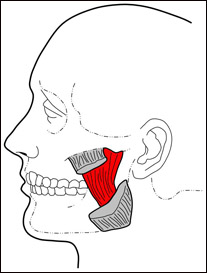This is a series on jaw pain and TMJ. If you missed the beginning, go back to Part 1. To find the masseter muscle, go back to Self-Treatment: Finding the bony landmarks. The NMT protocol for treatment is in the last two posts. The following self-treatment is from my Neuromuscular Therapy center near Boston.
The masseter (means a chewer) is outside of the angle of the jaw, a matching pair with the medial pterygoid on the inside.
 The superficial masseter angles across the space from the angle of the jaw upward and forward to the front two-thirds of the cheekbone. It refers pain into the lower jaw, teeth and side of the face.
The superficial masseter angles across the space from the angle of the jaw upward and forward to the front two-thirds of the cheekbone. It refers pain into the lower jaw, teeth and side of the face.
Treat the muscle externally on the upper attachment along the bone. To feel where it ends, put your fingers under your cheekbone and squeeze that side of your teeth together to feel the muscle tighten. You can press anywhere in the muscle, but the Trigger Points are found mainly at the attachments on the lower angle, the areas just above the top teeth and just below the lower teeth. Exhert pressure with your fingers using the NMT treatment protocol given in the last two posts.

The deep masseter is more important for TMJ and ear pain. It attaches above to the zygomatic process immediately forward of the TM joint and superficial to the lateral pterygoid. Below, it attaches deep to the superficial layer to the coronoid process and the ramus of the mandible. The only part you can externally access directly is fortunately just where the important TrP is located! It refers deep into the ear and can cause tinnitus (sounds like ringing and roaring in the ear). To treat it, close your jaw and find the soft depression in front of the tragus of the ear (see lateral pterygoid treatment). Press right there, using the NMT treatment protocol.
To treat the masseter from inside the mouth, open up to insert the thumb of the opposite hand inside your cheek and the fingers on the outside skin. Close your mouth and press your cheek out a bit with your thumb so you can squeeze the soft tissue between your thumb and fingers. Use your fingers to find the bony landmarks from the angle of your jaw to the zygomatic arch and match the positions with your thumb for compression treatment. Use the NMT protocol.
When you put your thumb toward the back of the jaw you’ll feel a thin ridge of bone outside of your teeth with your thumb tip. That’s the front edge of the ramus of the mandible. You won’t be able to get much in front of it to treat the deep masseter, but you can treat all along it, squeezing and holding any spot that is tender.
The next post will be about treating the temporalis.
I really like your self treatment posts for the TMJD problem muscles.
Thank you